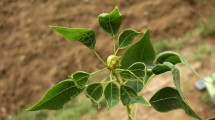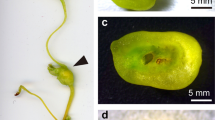Abstract
Many phytophagous insects have an ability to manipulate plant tissue and induce galls, but the mechanism is not yet fully understood. Some insects have multivoltine life cycles, and each generation induces galls on different plant species or different organs in the same host. Such host-use patterns are interesting study subjects to clarify the gall-inducing mechanisms of insects. We focused on a multivoltine and gall-inducing psyllid Stenopsylla nigricornis Kuwayama (Hemiptera: Psylloidea: Triozidae), which is associated with Symplocos lucida Sieb. (Symplocaceae). Based on periodic field surveys in Kyushu, Japan, S. nigricornis is revealed to have a bivoltine life history. Then, we revealed that the spring generation induces galls on leaves, while the autumn generation does so on flower buds and overwintering leaf buds. We also analyzed phytohormones in normal plant tissue, S. nigricornis nymphs, and their galls. As a result, nymphs were discovered to contain much higher concentrations of isopentenyladenosine and its possible precursor, isopentenyladenosine riboside than plant tissues, strongly suggesting that the phytohormone is involved in gall induction by S. nigricornis. Because flower bud galls contained significantly lower concentrations of abscisic acid (ABA) than normal flower bud, the autumn generation nymphs are considered to regulate the ABA level and to promote the earlier opening of host flower buds.







Similar content being viewed by others
References
Asami T, Sekimata K, Wang JM, Yoneyama K, Takeuchi Y, Yoshida S (1999) Preparation of (±)-[1, 2-13C2] abscisic acid for use as a stable and pure internal standard. J Chem Res, Synop 11:658–659
Askew RR (1984) The biology of gall wasps. In: Ananthakrishnan TN (ed) Biology of gall insects. Oxford and IBH Publishing Co., New Delhi, Bombay, Calcutta, pp 223–271
Csóka G, Stone GN, Merika G (2005) Biology, ecology, and evolution of gall-inducing Cynipidae. In: Raman A, Schaefer CW, Withers TM (eds) Biology, ecology, and evolution of gall-inducing arthropods. Science Publishers Inc, Enfield, pp 573–642
Dawkins R (1982) The extended phenotype. Oxford University Press, Oxford
De Bruyn LJ, Vandevyvere J, Jamié D, Prisen E (1998) The effects of gall formation by Lipara lucens (Diptera: Chloropidae) on its host Phragmites australis (Poaceae). In: Csóka G, Mattson WJ, Stone GN, Price PW (eds) The biology of gall-inducing arthropods. General technical report NC-199. USDA Forest Service, St. Paul, pp 173–187
Dorchin N, Hoffmann JH, Stirk WA, Novák O, Strnad M, van Staden J (2009) Sexually dimorphic gall structures correspond to differential phytohormone contents in male and female wasp larvae. Physiol Entomol 34:359–369
Kumashiro S, Matsukura K, Kawaura K, Matsumura M, Ogihara Y, Tokuda M (2011) Effect of barley chromosome addition on the susceptibility of wheat to feeding by a gall-inducing leafhopper. Naturwissenschaften 98:983–987
Kutsukake M, Meng X, Katayama N, Nikoh N, Shibao H, Fukatsu T (2012) An insect-induced novel plant phenotype for sustaining social life in a closed system. Nature Commun 3:1187
Mani MS (1964) Ecology of plant galls. Dr. W Junk Publishers, The Hague
Mapes CC, Davies PJ (2001) Cytokinins in the ball gall of Solidago altissima and in the gall forming larvae of Eurosta solidaginis. New Phytol 151:203–212
Matsukura K, Matsumura M, Tokuda M (2012) Host feeding by an herbivore improves the performance of offspring. Evol Biol 39:341–347
Miyatake Y (1976) Psyllidae of Tsushima Island. In: The Nagasaki Biological Society (ed) Creatures of Tsushima. The Nagasaki Biological Society, Nagasaki, pp 487–495 (in Japanese.)
Murata G (1989) Symplocaceae. In: Satake Y, Hara H, Watari S, Tominari T (eds) Wild flowers of Japan (Woody Plants II). Heibonsha Ltd., Publishers, Tokyo, pp 170–174
Price PW, Fernandes GW, Waring GL (1987) Adaptive nature of insect galls. Environ Entomol 16:15–24
Shorthouse JD, Wool D, Raman A (2005) Gall-inducing insects – nature's most sophisticated herbivores. Basic Appl Ecol 6:407–411
Stone GN, Schonrogge K (2003) The adaptive significance of insect gall morphology. Trends Ecol Evol 18:512–522
Straka JR, Hayward AR, Emery NRJ (2010) Gall-inducing Pachypsylla celtidis (Psyllidae) infiltrate hackberry trees with high concentrations of phytohormones. J Plant Interact 5:197–203
Suzuki H, Yokokura J, Ito T, Arai R, Yokoyama C, Toshima H, Nagata S, Asami T, Suzuki Y (2014) Biosynthetic pathway of the phytohormone auxin in insects and screening of its inhibitors. Insect Biochem Mol Biol 53:66–72
Tanaka Y, Okada K, Asami T, Suzuki Y (2013) Phytohormones in Japanese mugwort gall induction by a gall-inducing gall midge. Biosci Biotechnol Biochem 77:1942–1948
Tokuda M (2012) Biology of Asphondyliini (Diptera: Cecidomyiidae). Entomological Science 15:361–383
Tokuda M, Jikumaru Y, Matsukura K, Takebayashi Y, Kumashiro S, Matsukura M, Kamiya Y (2013) Phytohormones related to host plant manipulation by a gall-inducing leafhopper. PLoS ONE 8:e62350
Tooker JF, De Moraes CM (2011) Feeding by a gall-inducing caterpillar species increases levels of indole-3-acetic and decreases abscisic acid in Solidago altissima stems. Arthropod-Plant Interact 5:115–124
Tooker JF, Helms AM (2014) Phytohormone dynamics associated with gall insects, and their potential role in the evolution of the gall-inducing habit. J Chem Ecol 40:742–753
Uematsu K, Shibao H (2014) Formation of long-lasting galls by overwintered nymphs in the Japanese aphid Quadrartus yoshinomiyai (Hemiptera: Aphididae: Hormaphidinae) Entomological. Science 17:118–121
Wood BW, Payne JA (1988) Growth regulators in chestnut shoot galls infected with oriental chestnut wasp (Hymenoptera, Cynipidae). Environ Entomol 17:915–920
Yamaguchi H, Tanaka H, Hasegawa M, Tokuda M, Asami T, Suzuki Y (2012) Phytohormones and willow gall induction by a gall-inducing sawfly. New Phytol 196:586–595
Yukawa J, Masuda H (1996) Insect and mite galls of Japan in colors. Zenkoku Nôson Kyôiku Kyôkai, Tokyo (In Japanese with English explanations for color plates)
Zheng C, Halaly T, Acheampong AK, Takebayashi Y, Jikumaru K, Kamiya Y, Or E (2015) Abscisic acid (ABA) regulates grape bud dormancy, and dormancy release stimuli may act through modification of ABA metabolism. J Exp Bot 66:1527–1542
Acknowledgements
We thank Dr. K. M. Harris for his critical reading of an early draft and Dr. H. Inoue for his kind advice to observe psyllid ovaries.
Author information
Authors and Affiliations
Corresponding author
Additional information
Handling Editor: John F Tooker.
Appendices
Appendix 1: Seasonal changes in the bud status on Symplocos lucida and density of galls induced by Stenopsylla nigricornis at the census site from April 2013 to March 2014

Appendix 2: Seasonal changes in the bud status on Symplocos lucida and density of galls induced by Stenopsylla nigricornis at the census site from April to December 2014

Rights and permissions
About this article
Cite this article
Kai, S., Kumashiro, S., Adachi, S. et al. Life history of Stenopsylla nigricornis (Hemiptera: Psylloidea: Triozidae) and phytohormones involved in its gall induction. Arthropod-Plant Interactions 11, 99–108 (2017). https://doi.org/10.1007/s11829-016-9470-8
Received:
Accepted:
Published:
Issue Date:
DOI: https://doi.org/10.1007/s11829-016-9470-8




